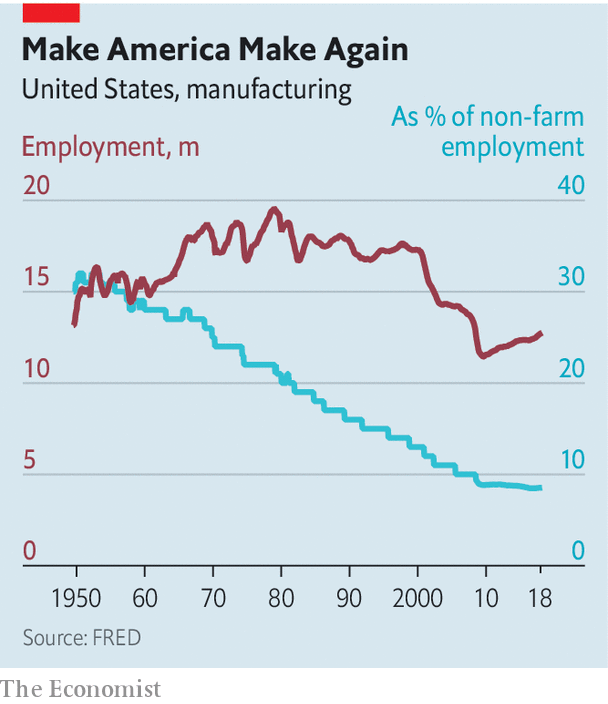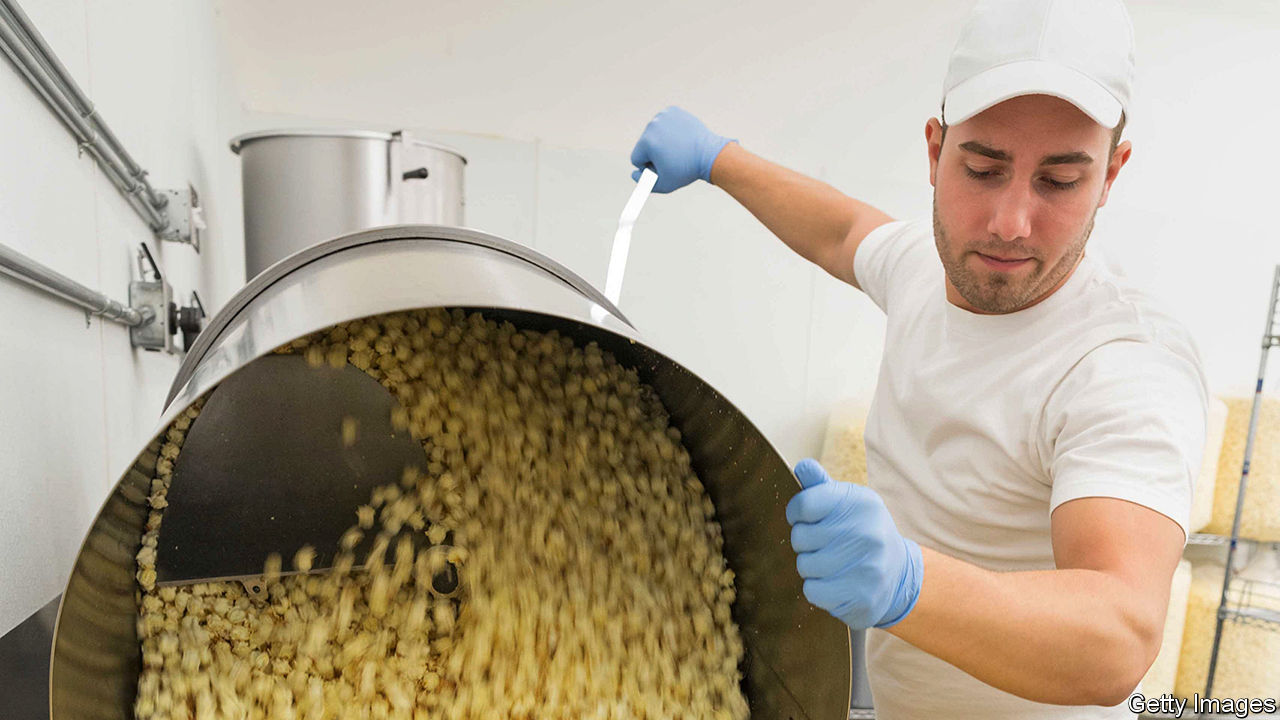
“NATION LONGS for one more day with dying manufacturing sector.” This headline, published in 2014 by the satirical website the Onion, anticipated both President Donald Trump’s fears and the retorts he gets from his critics. Mr Trump campaigned on a promise to bring back jobs in manufacturing after decades of decline. To those who see the future of the American economy in services, these promises seemed backward. When he was head of the National Economic Council, Gary Cohn reportedly asked the president which he would prefer: sitting in nice air-conditioned office, or standing on his feet all day.
In 2018 it looks as though the president is winning the day. Industrial output is on a tear, and the last few months have seen the best run for growth in manufacturing jobs since the late 1990s. After spending about two decades on a steady march downwards, manufacturing’s share of the labour market appears to have all but stopped falling. Between 1948 and 2008, manufacturing employment fell as a share of private non-farm employment by around 0.4 percentage points each year (see chart). Since January 2010 it has fallen by only 0.3 points in total.

Put another way, the number of American manufacturing jobs has been rising almost in line with overall employment for the past eight years, defying both historical experience and expectations. In the recoveries from the recessions of the 1990s and the 2000s manufacturing never regained its share of the labour market. In 2017 the Bureau of Labour Statistics forecast that the number of manufacturing jobs would continue to fall at an average annual rate of 0.6% per year between 2016 and 2026.
What is going on? It is possible that the surprising strength of manufacturing employment is a temporary phenomenon, and that it will soon revert to its earlier, downward trend. Is it a prelude to an industrial revolution, in which humans will be replaced by a more programmable kind of factory worker?
Peter Schott of Yale University points out, however, that over the past 60 years the norm has been for the number of manufacturing jobs to recover fully after downturns. The early 2000s was an exception because of a large increase in goods imported from China. If recovery is normal, perhaps it is unsurprising that the current one has lasted so long, because the downturn in 2008 was so deep.
Alternatively, the robustness of manufacturing jobs could reflect a more permanent shift. “It seems unlikely that the share of manufacturing employment will go to zero. Maybe we have hit the point where the share flattens off,” says Mr Schott. The trend is similar in both non-durable goods and durable goods industries, even though durable goods include things like cars, where sales tend to be more sensitive to the economic cycle.
Robert Lawrence of Harvard University argues that the shift away from manufacturing employment during the second half of the 20th century was mostly the result of gains in productivity, rather than competition from imports. More so than in other sectors, technological progress allowed fewer workers to make more stuff. Consumers did not respond to the resulting lower prices by buying very much more of that stuff, so employment fell.
Since the recession, productivity growth in manufacturing relative to services has slowed. Mr Lawrence calls the associated jobs boom the exception that proves the rule. Overall, one can have growth in manufacturing productivity, or growth in manufacturing employment, but not both, he suggests.
The lacklustre productivity growth could be a temporary feature of the economic cycle. An abundance of workers looking for jobs since the financial crisis has kept a lid on wage growth, perhaps blunting companies’ incentives to invest in labour-saving automation, thereby reducing productivity growth. According to numbers crunched by Nick Bunker of Indeed, a job-matching website, manufacturing is one of the few sectors where the number of unemployed workers continues to exceed the number of job openings.
Mr Trump’s brand of import-blocking economic nationalism is supposed to encourage companies to bring production back to America. It is possible that his threats to rip up trade deals and impose tariffs are making risk-averse business executives keener to plant their factories at home. However, tariffs on imported steel and aluminium could be pushing them in the opposite direction, by raising input costs for American factories. The same goes for tariffs on imported Chinese parts.
In any case, the manufacturing renaissance Mr Trump is presiding over does not mark a return to those bygone days when America was great. Historically, the sector was seen as a gateway into the middle classes for Americans with only a high-school education. But over time the composition of employment has shifted towards managerial and professional roles, and away from production jobs that can be done by those with less schooling. Manufacturing workers today are also less likely to be unionised than they once were, so they have fewer benefits.
The type of work being done is changing, too. The rise since 2011 in manufacturing employment has been concentrated production of food and transport equipment, which includes carmaking. Meanwhile, printing, computer-making and the production of clothes each account for a smaller share of manufacturing jobs than they did seven years ago.
Where did we go right?
Jobs are also moving geographically. Since the recovery started, the East North Central region, which includes places like Michigan and Illinois, has captured a share of employment gains that exceeds its share of job losses during the recession. Meanwhile the Middle Atlantic region, which includes New York and Pennsylvania, has seen no net increase in manufacturing employment at all since 2011.
In politics, however, not all places are created equal. Calculations by The Economist suggest that the counties that voted for Mr Trump in November 2016 have experienced larger manufacturing job gains since 2011. They have also tended to see the largest gains since the election. In these places, manufacturing’s share of overall employment has risen relative to the rest of the country. Far from dying off, manufacturing in America appears to be humming the president’s tune.








